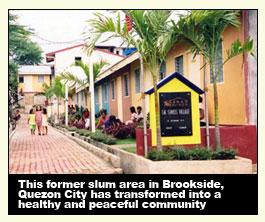
Gawad Kalinga Housing Project

*Extremes collide* I AM MELL DITANGCO (MY Pseudonym). Its either I talk about really heavy polical issues or I will talk about light hearted topics such as my pet dog, peanut! That is as simple as I can put it!






The Adopt-a-Farm Project is an original and innovative concept of the Municipality of Amadeo which aims to turn under-utilized and idle lands become productive. The project – an integrated component of the 10-year National Road Map for coffee endorsed by the Secretary of the Department of Agriculture and the National Coffee Development is also envisioned to provide extra income and generate jobs in the farmside.












Hey Dad look at me
Think back and talk to me
Did I grow up according
To plan?
Do you think I?m wasting
My time doing things I
Wanna do?
But it hurts when you
Disapprove all along
And now I try hard to make it
I just want to make you proud
I?m never gonna be good
Enough for you
I can?t pretend that
I?m alright
And you can?t change me
?Cuz we lost it all
Nothing lasts forever
I?m sorry
I can?t be Perfect
Now it?s just too late
And we can?t go back
I?m sorry
I can?t be Perfect
I try not to think
About the pain I feel inside
Did you know you used to be
My hero?
All the days
You spent with me
Now seem so far away
And it feels like you don?t
Care anymore
And now I try hard to make it
I just want to make you proud
I?m never gonna be good
Enough for you
I can?t stand another fight
And nothing? alright
?Cuz we lost it all
Nothing lasts forever
I?m sorry
I can?t be Perfect
Now it?s just too late
And we can?t go back
I?m sorry
I can?t be Perfect
Nothing?s gonna change
The things that you said
Nothing?s gonna make this
Right again
Please don?t turn your back
I can?t believe it?s hard
Just to talk to you
But you don?t understand
?Cuz we lost it all
Nothing lasts forever
I?m sorry
I can?t be Perfect
Now it?s just too late
And we can?t go back
I?m sorry
I can?t be Perfect
?Cuz we lost it all
Nothing lasts forever
I?m sorry
I can?t be Perfect
Now it?s just too late
And we can?t go back
I?m sorry
I can?t be Perfect


mell, I think what arcie took offense at the comparison of exporting logs and exporting OFWs. No one is "exporting" OFWs as they arent some commodity the government can market or exert control over.
People leave on their own accord after forming their own assesment of economic/career opportunies in both countries. While it may seem "intelligent" of people to see them as a collective and make presumptions on them as a whole, the fact is that they exist as individuals and arrive at life decisions on their own, regardless of how much "encouragement" the government provides. Benign03's choosing to work in Australia is a personal decision as is the choice of a OFW to sweat (live) it out in a desert kingdom (some of which are actually quite pleasant to live in based on anecdotal evidence). Why should either be seen as a "easy-way-out" solution?
Government officials are taking the easy way out by going around the world pleading with foreign nations to allow Filipinos to work in their land; then they plunder and sell out our futures to the elite and multinational companies, stunting our economy and thus perpetuating poverty and joblessness in our nation.
Same with the logs, instead of enforcing laws, government officials allow illegal logging to go on, as long as they get a piece of the action.
If the government officials do things regardless of the harm it does to the economy and make agreements with foreign nations to make it possible for our countrymen to go there, isn’t that taking the easy way out?
As a Filipino what else are you supposed to do if there are no jobs to support your family? The answer then becomes obvious.
Benign0 and I are speaking of the government taking the easy way out, not OFWs.
However, there is something to be said about Filipino parents working oversees and the possible harm it could bring to their children. But that’s another topic.